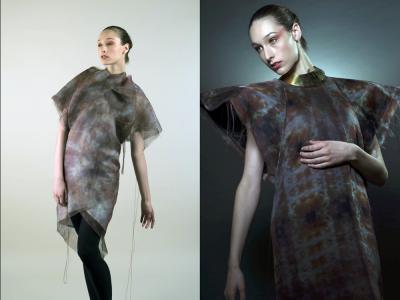Some people just don't know how to put patterns and colors together. Or anything about style.
Some of that is cultural, of course. No one really wears corsets any more, for example, and good luck finding anyone outside the Mid-East who knows what a caftan is. Some new technology may herald a future for fashion, its creator claims; computerized fabrics that change their color and their shape in response to movement.
Joanna Berzowska, professor and chair of the Department of Design and Computation Arts at Concordia University, has developed a prototype for an interactive electronic fabric that will harness power directly from the human body, store that energy, and then use it to change the garments' visual properties.
The major innovation of the project is the ability to embed these electronic or computer functions within the fiber itself: rather than being attached to the textile, the electronic components are woven into these new composite fibers. The fibers consist of multiple layers of polymers, which, when stretched and drawn out to a small diameter, begin to interact with each other. The fabric, produced in collaboration with the École Polytechnique's Maksim Skorobogatiy, is an advance in the development of "smart textiles."
"Our goal is to create garments that can transform in complex and surprising ways — far beyond reversible jackets, or shirts that change colour in response to heat. That's why the project is called Karma Chameleon," says Berzowska.
Boy George would be proud.

Karma Chameleon project Shoulder Dress. The collection shows garments in their multiple stages, low and high energy, enabled by future fibers and transformative textiles. Photo by Ronald Borshan © 2012, used with permission of Concordia.
It's not possible to manufacture clothing with the new composite fibers but Berzowska worked with fashion designers to create conceptual prototypes that can help visualize how such clothing might look and behave. "We won't see such garments in stores for another 20 or 30 years, but the practical and creative possibilities are exciting," says Berzowska. A dress that changes shape and color on its own, or a shirt that can capture the energy from human movement and use it to charge an iPhone, is interesting - but you have to wonder if 20 years is the timeframe because this is being done in academia. This could be developed tomorrow if a company thinks anyone would buy it.
Berzowska speculates there would also be a performative aspect to wearing such garments, whose dramatic transformations may or may not be controlled by the wearer. What would it mean to wear a piece of clothing with "a mind of its own" that cannot be consciously controlled? How much intimate contact with computers do we really want?
It's a mood ring, in clothing. No one is rethinking their existence over it.
Mood rings did not change the phenomenology of existence and neither will shiny clothes two decades from now. Link: ScienceMadeFun.net
Berzowska will present her findings at the Smart Fabrics 2013 conference this week in San Francisco. She has also written an article detailing her research for The Fashion Studies Handbook and an exhibit, to be held at the PHI Centre in the next year will give the public an opportunity to learn about her research, and to enter the imaginative space produced by her futuristic fabrics and clothing.






Comments